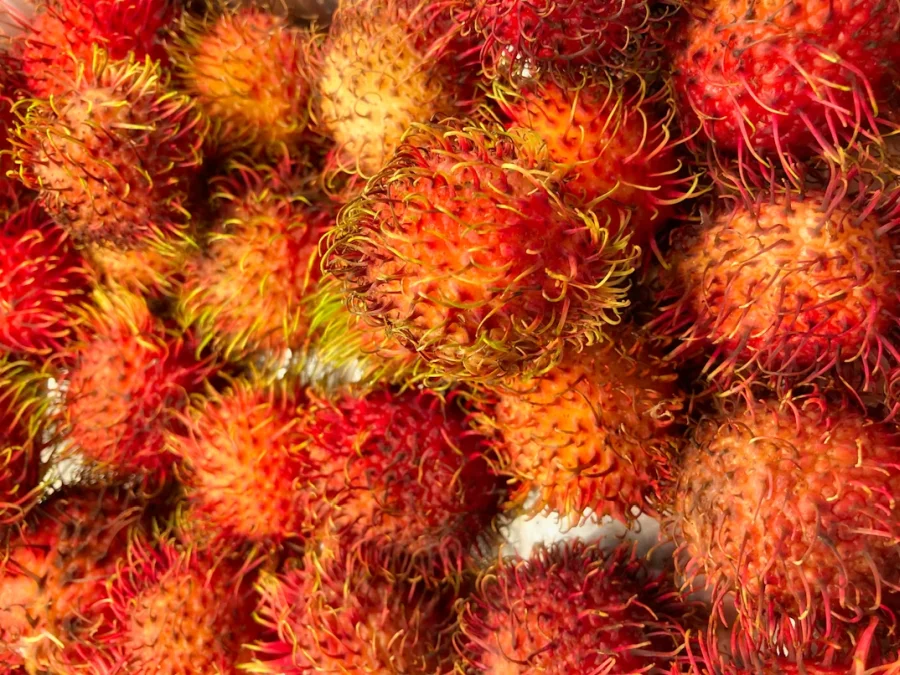
The rambutan stands as one of Southeast Asia’s most distinctive and beloved tropical fruits, earning its reputation as the “hairy jewel of the tropics” through its striking appearance and exceptional flavor. This exotic fruit, scientifically classified as Nephelium lappaceum, belongs to the Sapindaceae family and has captivated fruit enthusiasts worldwide with its unique combination of visual intrigue and culinary excellence.
The name “rambutan” derives from the Malay word “rambut,” meaning hair, a reference that becomes immediately apparent upon first encounter with this remarkable fruit.
Its bright red or yellow exterior is covered in soft, curved spines that give it an almost otherworldly appearance, while beneath this unusual exterior lies sweet, translucent flesh that offers a delightful contrast of textures and flavors.
At first glance, the rambutan presents an intimidating facade to the uninitiated. Its golf ball-sized form bristles with gentle spikes, creating an appearance that seems more decorative than edible. However, this distinctive exterior serves as nature’s protective packaging for one of the tropics’ most prized culinary treasures.
Botanical Characteristics
The rambutan tree typically reaches heights of 15 to 25 meters, exhibiting a dense, rounded canopy with compound leaves. This evergreen belongs to the same family as lychee and longan, sharing similar growth patterns and fruit development characteristics.
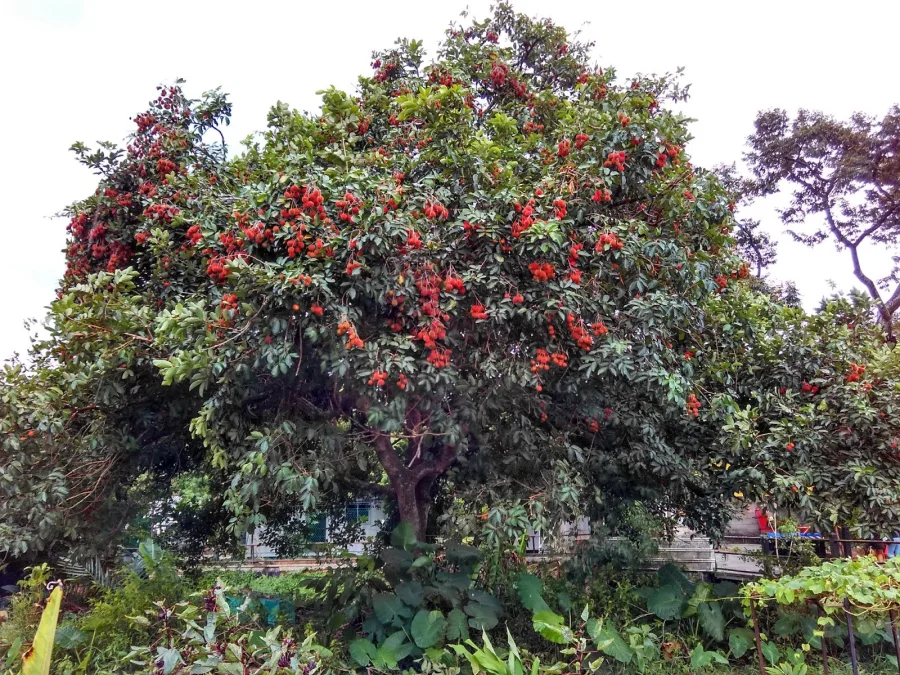
The fruit measures approximately 3 to 6 centimeters in diameter, with soft, flexible spines covering the entire surface.
These spines are actually modified hair-like structures that provide protection.
The fruit’s skin ranges from bright red to golden yellow when ripe, while beneath lies translucent, pearl-white flesh surrounding a single large seed. The flesh possesses a firm yet yielding texture similar to grapes, with a flavor profile combining sweetness with subtle floral notes.
Origins and Distribution
Archaeological evidence traces the rambutan’s origins to the tropical rainforests of Southeast Asia, with Malaysia and Indonesia as its ancestral home.
From these origins, the fruit gradually spread throughout the region through natural distribution and human cultivation.
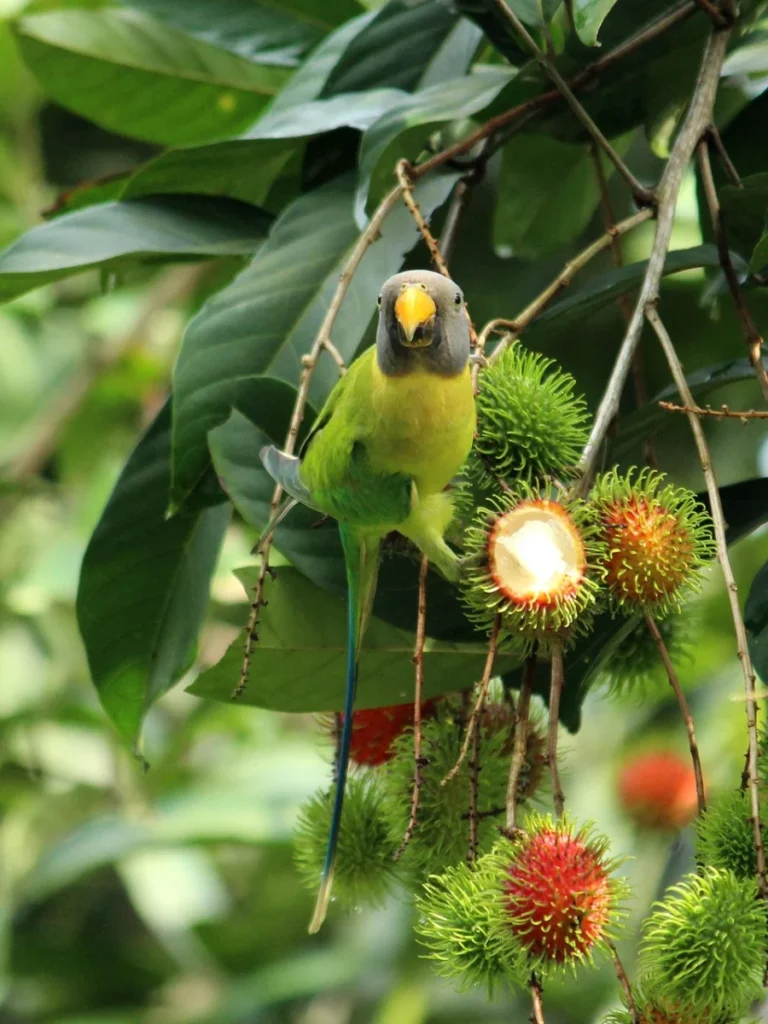
Today, rambutan cultivation extends across tropical regions worldwide, with significant commercial production in Thailand, Malaysia, Indonesia, the Philippines, and Vietnam.
Countries such as Costa Rica and Honduras have also established successful rambutan industries. The fruit requires consistently warm temperatures (22°C to 30°C), high humidity, and well-distributed rainfall, naturally limiting cultivation to equatorial zones.
Nutritional Profile
Rambutan delivers impressive nutritional value within its modest caloric footprint. A 100-gram serving contains approximately 68 calories, primarily from natural sugars that provide quick energy without crashes associated with processed sweeteners.
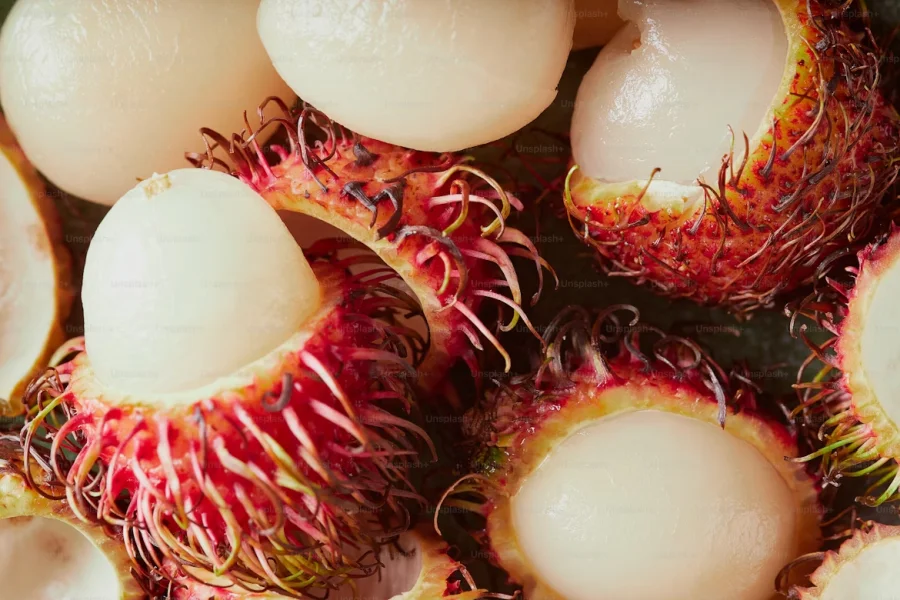
Vitamin C stands out as the fruit’s most significant nutritional contribution, providing approximately 40% of the daily recommended intake per 100-gram serving.
This supports immune function, collagen synthesis, and antioxidant protection. The fruit also contains meaningful amounts of copper, manganese, and potassium, essential for various metabolic processes.
The carbohydrate content, primarily natural sugars including glucose, fructose, and sucrose, provides readily available energy while maintaining a relatively low glycemic impact. Rambutan also contains phenolic compounds and flavonoids that contribute to its antioxidant properties.
Cultivation and Agriculture
Rambutan cultivation requires careful attention to environmental conditions and tree management. Trees typically begin producing fruit 5 to 6 years after planting, with peak production between 15 and 20 years of age.
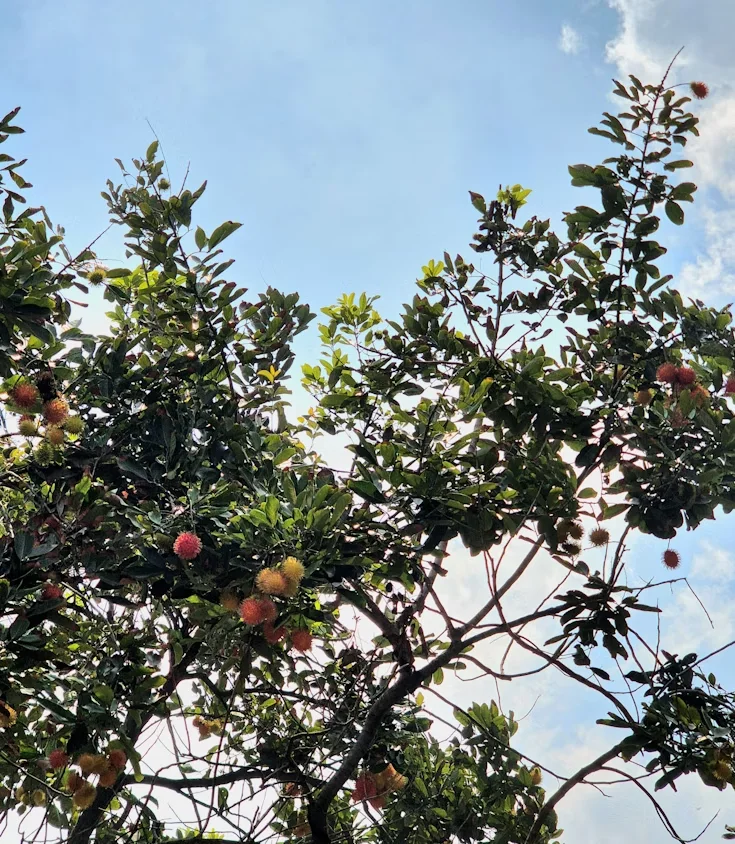
Mature trees can produce 50 to 200 kilograms annually, depending on variety and growing conditions.
Grafting represents the preferred propagation technique for commercial cultivation due to its ability to maintain consistent fruit quality and accelerate production timelines.
The trees require well-draining, fertile soils with pH levels between 5.5 and 6.5, demonstrating sensitivity to waterlogging. Regular fertilization and integrated pest management support sustained production and fruit quality.
Culinary Uses
Fresh consumption remains the most popular method of enjoying rambutan, though culinary applications extend much further.
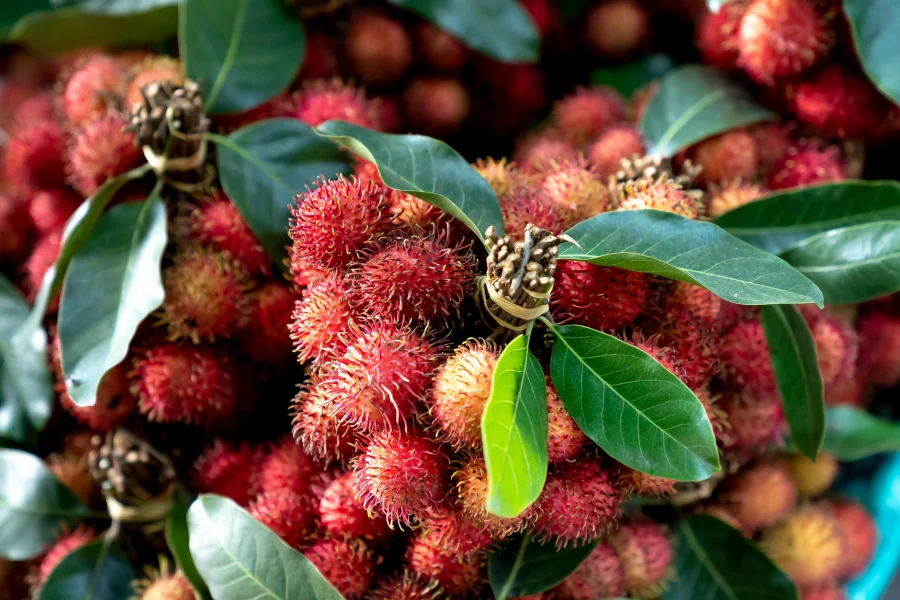
The sweet, floral flavor and unique texture make rambutan an excellent addition to fruit salads, creating visual appeal alongside flavor complexity.
In Southeast Asian cuisine, rambutan appears in both sweet and savory applications. Thai and Malaysian desserts often incorporate rambutan into coconut-based sweets, ice creams, and traditional preserved fruit preparations.
The fruit’s natural sweetness pairs exceptionally well with coconut milk, creating harmonious flavor combinations.
Beverage applications include fresh juices, smoothies, and cocktails, where the fruit’s unique flavor adds tropical complexity. Preservation methods such as canning, drying, and freezing allow for extended enjoyment beyond the natural harvest season.
Economic Importance
The global rambutan trade represents a significant sector within the tropical fruit industry, with annual production estimated at several hundred thousand tons worldwide. Thailand leads global production, followed by Malaysia, Indonesia, and the Philippines, supplying both domestic and international markets.
Export markets include Europe, North America, and various Asian countries, where rambutan commands premium prices due to its exotic status.
The industry provides employment across multiple sectors, from agricultural production to retail distribution, contributing significantly to rural economies in producing regions.
Cultural Significance
Throughout Southeast Asia, rambutan holds deep cultural significance extending beyond its commercial role. In Malaysian and Indonesian cultures, the fruit appears in traditional ceremonies and festivals, symbolizing abundance and prosperity.
Traditional medicine systems have historically utilized various parts of the rambutan tree for treating ailments.
Folk traditions commonly emphasize themes of hidden treasure and unexpected beauty—metaphors reflecting the fruit’s plain exterior concealing exceptional interior quality.
The fruit’s association with fertility and abundance makes it popular in wedding ceremonies and prosperity rituals throughout its native range.
Comparison with Related Fruits
Rambutan’s relationship to lychee and longan creates interesting comparisons. While all three share similar internal structure with translucent flesh surrounding a large seed, their external appearances differ dramatically.
Lychee features rough, pink-red skin without spines, while longan presents a smooth, tan-colored exterior.
Flavor profiles show both similarities and distinctions. Rambutan typically offers milder, more floral sweetness compared to lychee’s intense, perfumed flavor. Longan provides earthier undertones with less pronounced sweetness.
These differences influence culinary applications and consumer preferences across different markets.
Storage and Selection
Selecting high-quality rambutan requires attention to visual and tactile indicators. The skin should display vibrant coloration with spines that appear fresh and pliable rather than dried or brittle.
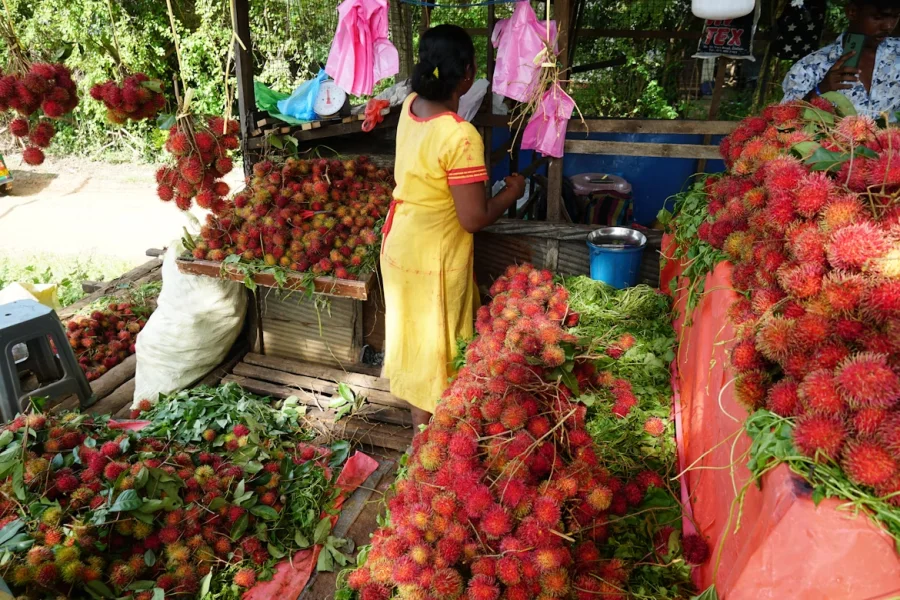
Fresh fruit should feel firm when gently squeezed and emit a subtle, pleasant aroma.
At room temperature, fresh rambutan maintains quality for 2 to 3 days, making prompt consumption advisable.
Refrigeration extends storage life to approximately one week, though some texture changes may occur. For longer storage, freezing provides options for extended preservation, though texture changes are inevitable.
Conclusion
The rambutan rightfully claims its title as the “hairy jewel of the tropics” through its remarkable combination of distinctive appearance, exceptional flavor, and cultural significance.
From its origins in tropical rainforests to its current status as a globally recognized exotic fruit, rambutan represents both agricultural achievement and natural wonder.
As international markets expand and consumer interest in exotic fruits grows, rambutan’s future appears promising despite challenges related to transportation and storage.
The fruit’s impressive nutritional profile, versatile culinary applications, and economic importance ensure its continued relevance in both traditional and modern food systems. This remarkable fruit stands as a testament to tropical biodiversity and nature’s capacity to create extraordinary flavors in unexpected packages.
Q&A
Why does my stomach hurt after eating rambutan?
Stomach discomfort after eating rambutan can occur for several reasons. You may have eaten too many at once, as the high fiber content can cause digestive upset when consumed in large quantities. Some people may also have a mild sensitivity to certain compounds in the fruit. Additionally, if the rambutan wasn’t fully ripe or was contaminated, it could cause stomach irritation. If you consistently experience pain after eating rambutan, consider reducing your portion size or consult a healthcare provider to rule out any allergies.
What is the glycemic index of rambutan?
Rambutan has a moderate glycemic index, typically ranging between 35-55, though exact values can vary depending on ripeness and preparation. This places it in the low to moderate GI category, meaning it causes a relatively gradual rise in blood sugar levels compared to high-GI foods. The fruit’s natural fiber content helps slow sugar absorption, making it a reasonable choice for most people, including those monitoring their blood glucose levels. However, individuals with diabetes should still consume it in moderation as part of a balanced diet.
Is rambutan a rare fruit?
Rambutan is not rare in its native Southeast Asian regions, where it’s commonly grown and consumed in countries like Malaysia, Thailand, Indonesia, and the Philippines. However, it can be considered relatively uncommon or exotic in Western countries, where it’s typically imported and may only be available in specialty Asian markets or high-end grocery stores. The fruit’s availability outside Southeast Asia depends on import logistics and local demand, making it less accessible but not truly rare on a global scale.
Can you eat rambutan seeds?
Rambutan seeds should not be eaten raw as they contain potentially harmful compounds and have a bitter taste. The seeds are tough and difficult to digest, and some sources suggest they may contain toxic substances when consumed in their natural state. However, in some traditional practices, the seeds are processed, roasted, or cooked before consumption, though this isn’t commonly recommended. For safety, it’s best to enjoy only the sweet, translucent flesh of the rambutan and discard the seed.